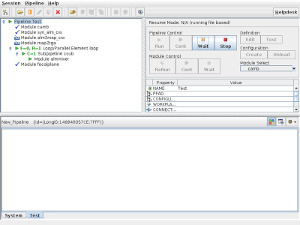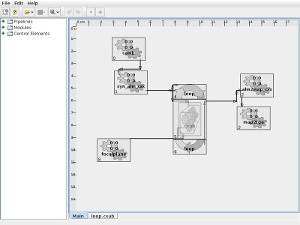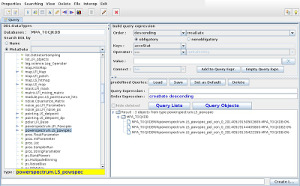|
|  |
The analysis of data from the Planck mission is a challenging task. The
telescope was scanning the whole sky in small stripes and at nine different
frequencies, continuously over several years. To convert the huge number of
individual observations into integrated maps of the whole sky, the raw data
streams have to be checked and calibrated. Afterwards, sky maps are constructed
for the nine frequency channels and those maps are analysed for both
astrophysical foreground signals and for their cosmological information content.
Furthermore, this complex data analysis has to be verified with simulations,
which take the relevant cosmological, astrophysical, and instrumental effects
into account.
To support these complex procedures, the Planck software group at MPA provided
essential parts of the Planck software infrastructure; in particular a
simulation package, a workflow engine and a database front end. Although
specifically designed for the requirements of the Planck project, these software
packages are useful for a larger community, as they facilitate generic tasks in
CMB data analysis as well as other data driven research areas.
The  ProC suite for workflows should have the broadest applicability. It consists of a graphical user
interface to construct complex data processing workflows out of a given set of
computer programs. The ProC workflow engine to actually execute these workflows
on computing clusters or in a computational grid. These are complemented by the
data management component to store and organize all data products. The user
can, for example, specify that only data products which are affected by a change
in the input data are updated selectively, avoiding unnecessary computations. As
it is very flexible, the ProC suite satisfies basic needs of data processing
centres, which have to be able to restructure their data processing along with
the development of a project. ProC suite for workflows should have the broadest applicability. It consists of a graphical user
interface to construct complex data processing workflows out of a given set of
computer programs. The ProC workflow engine to actually execute these workflows
on computing clusters or in a computational grid. These are complemented by the
data management component to store and organize all data products. The user
can, for example, specify that only data products which are affected by a change
in the input data are updated selectively, avoiding unnecessary computations. As
it is very flexible, the ProC suite satisfies basic needs of data processing
centres, which have to be able to restructure their data processing along with
the development of a project.
The  Planck simulation package takes a cosmological model specified by the user and
calculates a potential CMB sky consistent with this model, including
astrophysical foregrounds, and then performs a simulated observation of this
sky. This Simulation embraces many instrumental effects such as beam convolution
and noise. Alternatively, the package can simulate the observation of a provided
sky model, generated by another program such as the Planck simulation package takes a cosmological model specified by the user and
calculates a potential CMB sky consistent with this model, including
astrophysical foregrounds, and then performs a simulated observation of this
sky. This Simulation embraces many instrumental effects such as beam convolution
and noise. Alternatively, the package can simulate the observation of a provided
sky model, generated by another program such as the  Planck Sky Model software.
The Planck simulation package does not only provide Planck-like data, it can also be easily
adopted to mimic the properties of other existing and upcoming CMB experiments.
Therefore, it is a valuable and generic tool for CMB research. Planck Sky Model software.
The Planck simulation package does not only provide Planck-like data, it can also be easily
adopted to mimic the properties of other existing and upcoming CMB experiments.
Therefore, it is a valuable and generic tool for CMB research.
The Planck software development at MPA was funded by the German Space
Administration of the German Aerospace Center on behalf of the Federal Ministry
for Economic Affairs and Energy as well as by the Max Planck Society. This
development was led by Matthias Bartelmann until 2003 and by Torsten Enßlin
since then.
 Planck is a project of the European Space
Agency (ESA) with instruments provided by two scientific consortia funded by ESA
member states and led by Principal Investigators from France and Italy,
telescope reflectors provided through a collaboration between ESA and a
scientific consortium led and funded by Denmark, and additional contributions
from NASA (USA). Planck is a project of the European Space
Agency (ESA) with instruments provided by two scientific consortia funded by ESA
member states and led by Principal Investigators from France and Italy,
telescope reflectors provided through a collaboration between ESA and a
scientific consortium led and funded by Denmark, and additional contributions
from NASA (USA).
Torsten Enßlin
Links:
 Planck Mission Planck Mission
 ProC workflow engine ProC workflow engine
 Planck Sky Model Planck Sky Model
 Planck Legacy Archive Planck Legacy Archive
 Planck Simulation Package Planck Simulation Package
Contact:
Dr. Torsten Enßlin
Max-Planck-Institut für Astrophysik
Tel.: +49 89 30000-2243
email: tensslin mpa-garching.mpg.de mpa-garching.mpg.de
|






 mpa-garching.mpg.de
mpa-garching.mpg.de